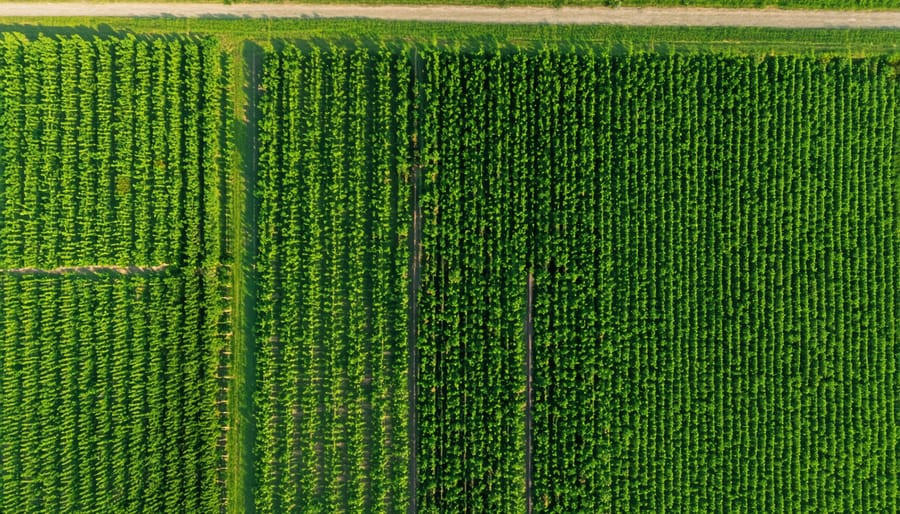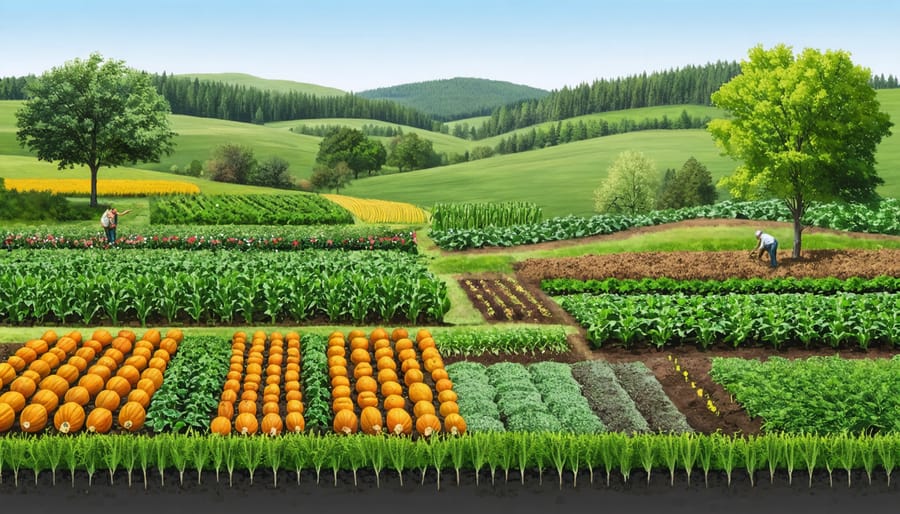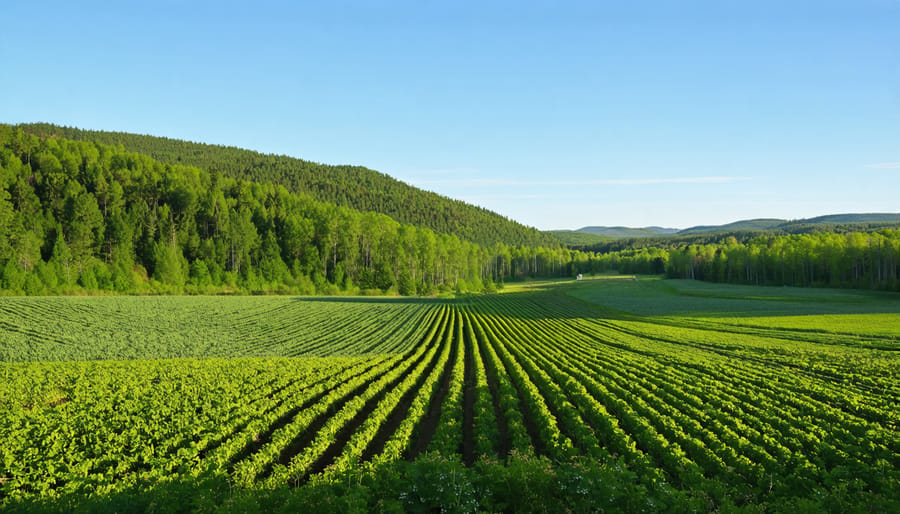Nutrient cycling in agroecosystems represents the cornerstone of sustainable agriculture, where essential elements like nitrogen, phosphorus, and carbon flow continuously between soil, plants, and the atmosphere. In Alberta’s diverse agricultural landscape, these natural processes drive farm productivity while reducing dependency on synthetic inputs. When properly managed, nutrient cycles create self-sustaining systems that enhance soil fertility, improve crop yields, and strengthen ecosystem resilience.
Modern agricultural practices often disrupt these vital cycles, but innovative farmers across the Canadian prairies are demonstrating how working with natural processes can regenerate soil health while maintaining profitable operations. By understanding and optimizing nutrient flows through cover cropping, crop rotation, and integrated livestock management, producers can build systems that maximize nutrient use efficiency while minimizing environmental impact.
The science behind nutrient cycling reveals a complex web of biological interactions, yet its practical application offers straightforward solutions for today’s agricultural challenges. From microscopic soil organisms to large-scale farming operations, every component plays a crucial role in maintaining healthy, productive agroecosystems that will sustain future generations of Canadian farmers.
How Trees Transform Your Farm’s Nutrient Game
Root Networks: Your Underground Nutrient Highway
Think of tree root networks as nature’s underground superhighway system, connecting different parts of your agroforestry system in ways that benefit your entire operation. These complex networks, which can extend several metres below the surface, do more than just anchor trees – they’re active trading zones for nutrients and resources.
In Alberta’s diverse soil conditions, root systems play a crucial role in moving nutrients throughout your land. Through partnerships with beneficial fungi called mycorrhizae, tree roots can access and transport nutrients that would otherwise be unavailable to crops. This natural system enhances soil health while providing carbon sequestration benefits that contribute to long-term soil fertility.
What’s particularly impressive is how these root networks share resources. When one tree accesses water or nutrients, it can transfer these resources to neighbouring plants through underground connections. This cooperative system is especially valuable during our challenging prairie growing seasons, helping maintain crop resilience during dry spells and ensuring more efficient nutrient use across your entire agricultural system.

Leaf Litter: Nature’s Free Fertilizer
Every autumn, as trees shed their leaves, nature provides farmers with a valuable resource that can significantly improve soil health at no cost. Here in Alberta, leaf litter from shelterbelts and woodlots creates a natural fertilizer system that’s particularly beneficial for our agricultural lands.
When leaves fall, they create a protective blanket over the soil, gradually breaking down through winter and spring. This decomposition process releases essential nutrients like nitrogen, phosphorus, and potassium back into the soil. For every hectare of deciduous trees, you can expect anywhere from 3 to 5 tonnes of leaf litter annually, contributing roughly 50-80 kg of nitrogen to your soil.
Rather than removing fallen leaves, consider incorporating them into your field management strategy. They not only add nutrients but also support beneficial soil organisms and help retain moisture. Many successful Alberta farmers leave leaf litter in place, particularly around fruit trees and in market gardens, where this natural mulch provides multiple benefits throughout the growing season.

Alberta Success Stories: Real Farms, Real Results

The Davidson Family Farm Transformation
Located just outside of Leduc, Alberta, the Davidson Family Farm’s transformation into a nutrient cycling powerhouse demonstrates how traditional farming operations can successfully adopt climate-resilient farming practices. In 2018, Sarah and Mike Davidson began transitioning their 400-hectare grain farm into an integrated system that maximizes nutrient cycling through strategic crop rotation and livestock integration.
The Davidsons introduced a mix of cattle grazing and cover crops to their existing canola and wheat rotation. They planted shelter belts of native species like trembling aspen and white spruce, which now serve as windbreaks while cycling nutrients deep from the soil. Livestock manure is carefully managed through rotational grazing, ensuring even distribution across pastures.
After four years, soil tests revealed a 40% increase in organic matter content and significantly improved water retention. Crop yields have stabilized, showing greater resilience during drought periods. The farm’s input costs have decreased by 30%, primarily due to reduced fertilizer requirements.
The most notable achievement has been the farm’s ability to maintain productivity during extreme weather events. During the 2021 drought, the Davidsons’ yields remained at 85% of their five-year average, while many neighboring farms experienced more significant losses. Their success has inspired local farmers to adopt similar practices, creating a growing community of regenerative agriculture practitioners in central Alberta.
Measuring Success: Key Performance Indicators
To effectively monitor nutrient cycling in your agroecosystem, focus on these key performance indicators (KPIs) that Alberta farmers have found most valuable. Start by measuring soil organic matter content through regular testing, aiming for annual increases of 0.1-0.5%. Track your soil’s nutrient levels, particularly nitrogen, phosphorus, and potassium, through seasonal soil tests.
Monitor crop yield data across different fields and seasons, comparing areas with different nutrient management strategies. A successful system typically shows steady or increasing yields while reducing external inputs. Keep detailed records of fertilizer applications and costs – many Alberta farmers report 15-30% reduction in fertilizer needs after implementing effective nutrient cycling practices.
Plant tissue testing during key growth stages can reveal nutrient uptake efficiency. Look for improved nutrient density in crops and consistent growth patterns. Measure biological activity through earthworm counts (aim for 8-10 per 30 cm² soil pit) and observe root development patterns.
Water quality indicators are equally important – regular testing of nearby water sources should show stable or decreasing nutrient levels, indicating minimal leaching. Track your farm’s nutrient balance sheet, comparing inputs versus outputs annually. Document visual indicators like soil structure, plant health, and residue decomposition rates through photo monitoring and field notes.
Remember, successful nutrient cycling shows gradual improvements over multiple growing seasons, so maintain consistent monitoring practices for the most accurate assessment.
Setting Up Your Own Nutrient Cycling System
Tree Selection for Alberta’s Climate
When selecting trees for nutrient cycling in Alberta’s climate, it’s essential to choose species that can withstand our unique growing conditions while contributing effectively to soil health. Native species like trembling aspen and balsam poplar are excellent choices, as they’ve naturally adapted to our climate and soil conditions. These species also form beneficial relationships with soil microorganisms, enhancing nutrient availability.
White spruce and lodgepole pine work well in shelterbelts and windbreaks while contributing to nutrient cycling through their needle drop and root systems. For fruit-producing options that support both nutrient cycling and farm income, hardy varieties of apple trees developed at the University of Saskatchewan, such as Goodland and Parkland, have proven successful in Alberta’s climate.
Green ash and Manitoba maple are particularly valuable for their deep root systems and abundant leaf litter, which add organic matter to the soil. These species are also known for their ability to fix nitrogen and improve soil structure, making them ideal choices for agroforestry systems in our region.
When planning your tree selection, consider your specific site conditions. Areas with good drainage might support hybrid poplars, which grow quickly and produce substantial biomass for nutrient cycling. In more exposed areas, American elm and Northwest poplar have demonstrated excellent wind resistance while contributing to soil improvement.
Local success stories include farmers in central Alberta who’ve integrated Siberian larch and silver maple into their systems, reporting improved soil conditions within five years of establishment. Remember to source your trees from local nurseries that understand Alberta’s growing conditions and can provide guidance on establishment techniques.
Layout and Spacing Strategies
Effective layout and spacing in nutrient cycling systems can significantly boost your farm’s productivity while maintaining ecological balance. In Alberta’s diverse climate zones, the key is to arrange your plantings in a way that maximizes nutrient exchange while considering our unique growing conditions.
For annual crops, implement strip cropping with 15-20 metre widths, alternating between nitrogen-fixing legumes and heavy feeders like cereals. This arrangement allows for optimal nutrient sharing while providing practical access for farm equipment. Consider our prevailing winds when planning your strips – running them north-south typically works best in most Alberta locations.
When incorporating trees and shrubs, space them according to their mature size, typically 5-8 metres apart for most species. Create zones of influence by placing nitrogen-fixing trees like buffaloberry or sea buckthorn upwind of your primary crops. This strategic placement ensures that falling leaves and root interactions benefit your target growing areas.
For livestock integration, divide pastures into paddocks of 1-2 hectares, rotating animals every 3-5 days depending on vegetation growth. This approach prevents soil compaction and allows for even nutrient distribution through manure. Leave at least 30 days between grazing periods to enable proper nutrient cycling and plant recovery.
Create buffer zones of 3-5 metres between different system components to prevent nutrient competition while maintaining beneficial interactions. These spaces can serve as paths for maintenance access and act as wildlife corridors, supporting overall biodiversity.
Remember to adjust these measurements based on your specific soil type and moisture conditions. Sandy soils might require tighter spacing to maintain moisture, while clay soils may need more room for root development.
Implementing nutrient cycling in your agroecosystem offers tremendous benefits for both your farm’s productivity and environmental sustainability. By adopting these practices, Alberta farmers can reduce input costs by up to 30% while improving soil health and crop yields. The natural cycling of nutrients through crops, livestock, and soil creates a more resilient farming system that can better withstand climate challenges while contributing to Canada’s agricultural sustainability goals.
Take the first step today by starting small – perhaps with cover cropping or rotational grazing on a portion of your land. Connect with local agricultural extension services and fellow farmers who have successfully implemented these systems. Remember, every positive change in nutrient management strengthens our farming community and helps secure a prosperous future for Alberta agriculture. Your actions today will help build a more sustainable tomorrow for generations of farmers to come.










